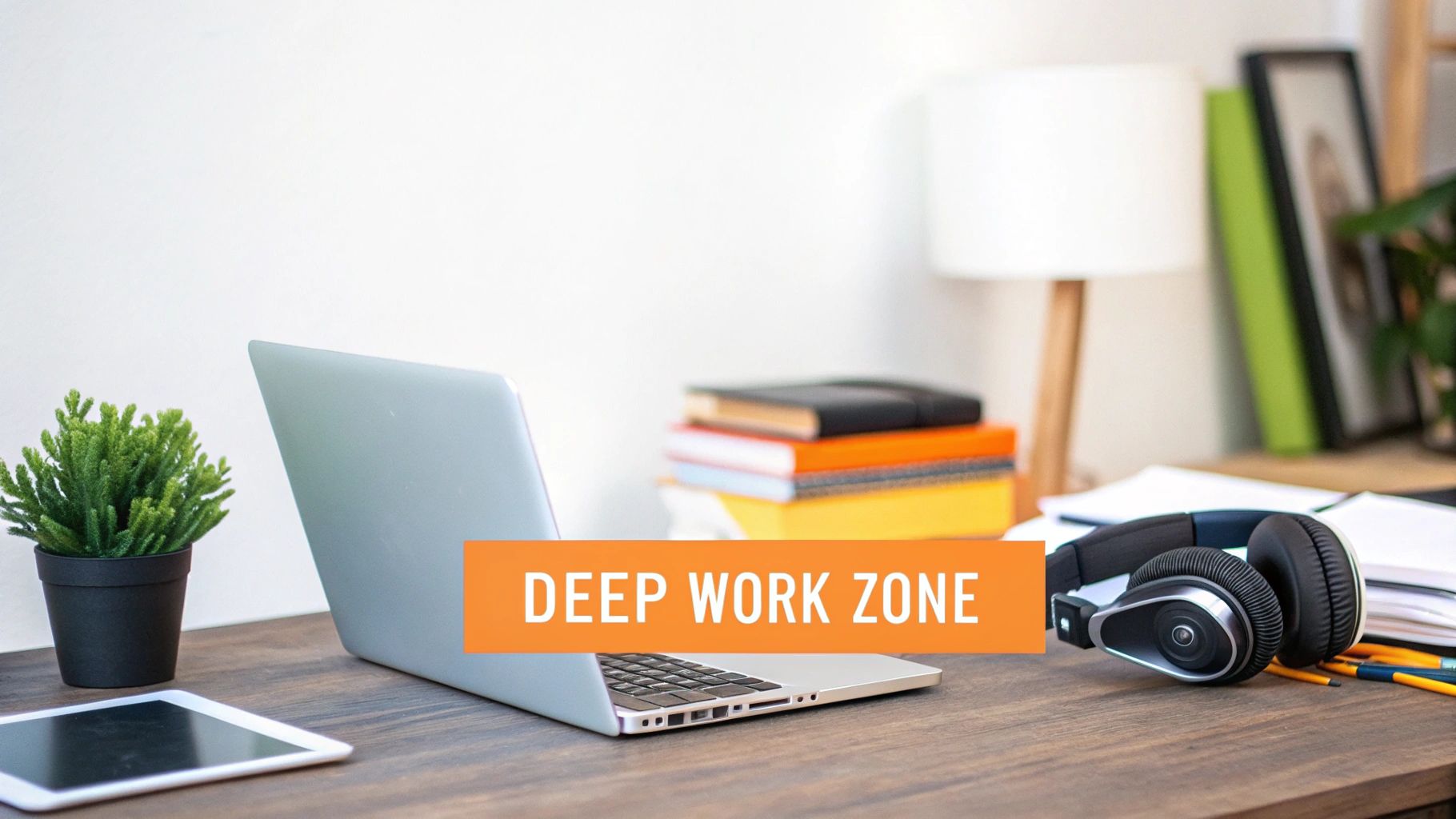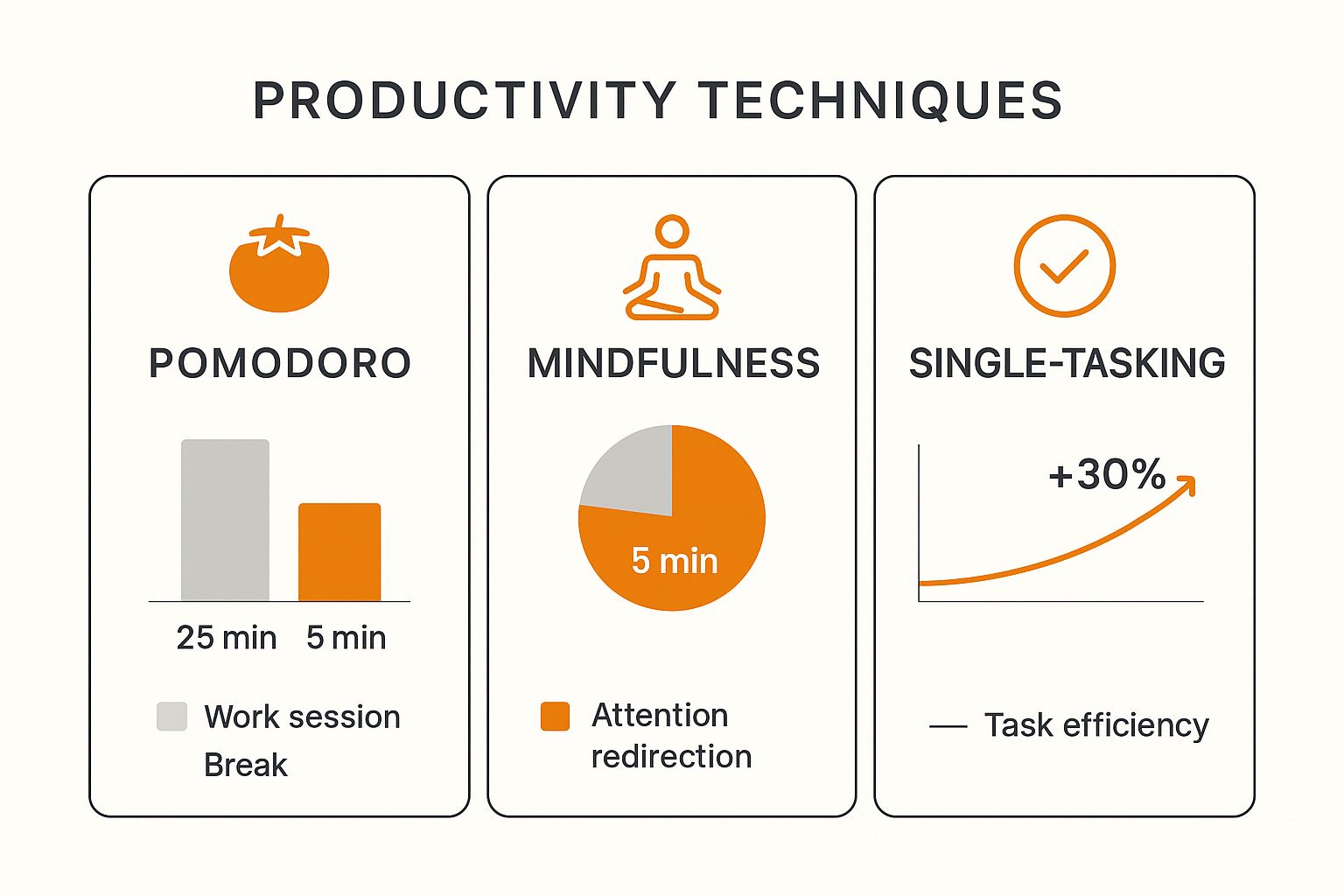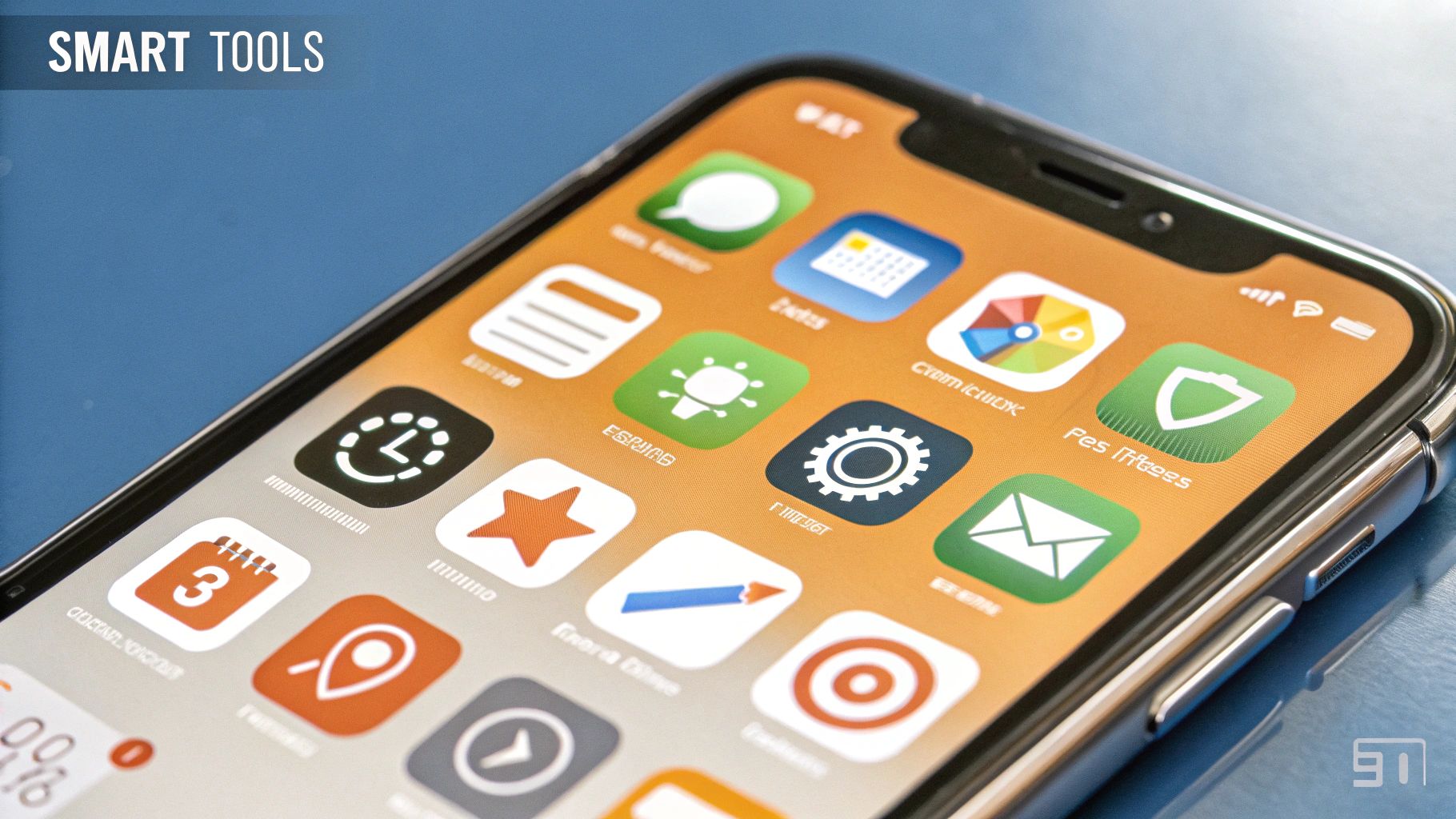
How to Improve Focus and Concentration Today
Oct 14, 2025
To boost your focus, the first step is often the simplest: identify what’s pulling you away and set up a workspace that’s just for work. From there, try techniques like time-blocking to schedule focused work sessions. For example, block out 9:00 AM to 10:30 AM in your calendar for "Draft Project Proposal" and treat it like an unbreakable appointment. This isn't about sheer willpower; it's about creating a structure where your brain isn't constantly fighting for a moment of peace.
Why Staying Focused Feels Impossible and How to Fix It

Let's be real—trying to concentrate these days can feel like an uphill battle in a sandstorm. If you feel like your attention is constantly being hijacked, you're not alone. Our digital world, with its endless pings and the pervasive myth of multitasking, is practically designed to break your focus.
This isn't just a feeling; it's a stark reality backed by data. Researchers at the University of California, Irvine, tracked a startling decline in our ability to stay on task. Back in 2004, the average attention span on a single screen was a respectable 2.5 minutes. Fast forward to 2020, and that number plummeted to just 47 seconds.
What’s even more eye-opening is the recovery time. It takes an average of 25 minutes to get back into a state of deep focus after you’ve been interrupted. Think about how many times that happens in a single hour.
The heart of the problem is that we treat our focus like it's a bottomless well. It's not. It's a finite resource, and every notification, every "quick peek" at your email, and every time you switch tasks, you're draining that precious cognitive battery.
Reclaiming Your Mental Clarity
If you genuinely want to learn how to improve focus and concentration, you need a plan that goes beyond just "trying harder." The real solution lies in building a system of actionable habits that supports your brain’s natural capacity for deep work.
Here’s a glimpse of the core strategies we'll unpack:
Understanding Your Unique Attention Patterns: Discover your peak focus times and personal kryptonite-level distractions so you can work with your brain, not against it.
Optimizing Your Environment: Learn practical ways to design your physical and digital spaces to act as a fortress against interruptions.
Training Your Mind Like a Muscle: We’ll explore targeted mental exercises you can do daily to build focus endurance and resilience.
Using Technology to Your Advantage: It’s time to turn your devices from your biggest distractors into your most powerful allies for concentration.
This journey is about more than sheer willpower; it’s deeply connected to core cognitive skills. For a broader look at conquering distractions, you can also explore some great strategies on how to focus better and reclaim your attention. Think of this as your starting point for taking back control with small, but powerful, changes.
Discovering Your Personal Focus Profile
Generic advice on how to improve focus often falls flat because it ignores a simple truth: you are unique. Before you can build habits that actually stick, you need to understand your own mental landscape. This starts with a personal 'attention audit' to map out your unique focus profile.
Think of it as being a detective investigating your own attention patterns. For one week, the goal isn't to judge your habits, but simply to gather data. A simple journal or a note on your phone is all you need.
Start tracking when you feel sharpest and when your mind starts to wander. Is it at 10 AM after your morning coffee, or do you hit your stride in the late afternoon? Pinpointing these peak concentration windows is a powerful, actionable insight. For example, if you realize you're most alert between 9 AM and 11 AM, schedule your most mentally demanding task—like analyzing data or writing a complex report—during that block.
Identifying Your Unique Distraction Triggers
Once you have a feel for your natural energy rhythms, the next layer is to identify what specifically pulls you off task. These distractors come in two main flavours, and you need to get a handle on both.
External Distractors: These are the obvious culprits in your environment. It could be the constant ping of notifications, a chatty coworker, or the TV humming in the background.
Internal Distractors: These are much sneakier. They’re the nagging thoughts of an upcoming deadline, worries about a personal issue, or even just the physical distraction of feeling hungry or tired.
Your audit might reveal that a "quick" social media check at 11 AM consistently turns into a 30-minute productivity black hole. Or maybe you'll notice your concentration nosedives right after a heavy, carb-rich lunch. This is where self-awareness becomes your most powerful tool. A practical step would be to set a recurring phone alarm for 10:55 AM with the reminder: "Do not open social media. Take a walk instead."
The biggest leaps in focus don’t come from sheer willpower. They come from strategically designing your day around your natural tendencies and known weaknesses.
Understanding these patterns is the foundation for any personalized strategy. A lifespan study on sustained attention revealed that our ability to concentrate naturally fluctuates, peaking in young adulthood and changing as we age. Recognizing where you are on this spectrum can add valuable context to your personal profile. You can explore more on these findings about attention span across different ages.
This kind of detailed self-knowledge helps you move from generic tips to targeted solutions that work for you. If you want to take this a step further, objective data can offer even deeper insights. You might be interested in our professional cognitive assessments to get a precise baseline of your attention and other cognitive skills. The information you gather here will directly inform the environmental and behavioural changes we’ll explore next.
Designing an Environment for Deep Work

We often think focus is all about willpower, but what if your environment could do most of the work for you? Your ability to concentrate isn't just in your head; it's directly tied to your surroundings. Instead of constantly fighting off distractions, you can architect your physical and digital spaces to make deep, uninterrupted work the default setting.
Let's start with the digital noise. The first actionable step is to reclaim control of your notifications. On your phone, go to Settings > Notifications and turn off alerts for all non-essential apps like social media, news, and games. Leave on only those from key people or critical work tools.
Imagine a marketing manager trying to write a complex campaign brief. A practical action is to use a browser extension like Freedom or BlockSite to temporarily block distracting websites for a 90-minute work session. This creates a digital fortress, making it infinitely easier to stay on task. A clean, minimalist desktop with only the apps you need open also cuts down on visual clutter and mental friction.
Optimizing Your Physical Workspace
Your physical setup is just as critical. A cluttered, dim, or noisy space forces your brain to work overtime just to tune out the chaos. Fixing your workspace isn't just about aesthetics; it's a high-impact strategy for preserving your cognitive horsepower.
Here are a few actionable adjustments that make a massive difference:
Lighting Matters: If possible, position your desk to face a window for natural light. If you can't, buy a "daylight" LED bulb for your desk lamp to reduce eye strain and fatigue.
Declutter Your Desk: At the end of each day, take two minutes to put away everything except your monitor, keyboard, and mouse. This simple habit ensures you start the next day with a clean slate.
Control the Sound: Invest in noise-cancelling headphones. They create a personal bubble of quiet, signaling to yourself and others that you're in deep work mode. This is especially crucial in a busy home or open office.
Think of your workspace as a cockpit designed for a single mission: focus. Every single element should serve a purpose, helping you navigate your tasks with precision and minimal interference.
Creating Focus-Enhancing Rituals
A supportive environment goes beyond physical objects; it’s also about building powerful rituals. These routines connect your physical space to a specific mental state, priming your brain for concentration.
A great practical example is the software developer who starts their day by putting their phone in a drawer in another room and dedicating the first 90 minutes to coding with the internet completely disconnected. This simple ritual removes the number one source of distraction right when their creative energy is at its peak.
You can create a similar habit by designating a specific chair or corner of a room only for deep work. Over time, your brain builds a strong association between that physical spot and intense focus, making it easier to drop into a state of flow. These practices are a form of self-directed behavioural change, tapping into the same principles that power many successful cognitive therapies that help people retrain their responses to environmental cues.
Practical Techniques to Train Your Attention
Think of your ability to concentrate as a muscle. Just like any other muscle, it gets stronger with consistent training. Focus isn't an innate talent; it’s a skill you can build. The trick is to stop just "trying harder" and start using structured techniques that build real cognitive endurance.
A fantastic starting point for many is the Pomodoro Technique. It's a simple, actionable method: set a timer for 25 minutes and give one task your undivided attention. When the timer goes off, take a 5-minute break to stretch or grab some water. This cycle helps keep mental fatigue at bay and makes even the most intimidating projects feel manageable.
The Power of Single-Tasking
Our culture often puts multitasking on a pedestal, but the science is clear: our brains aren't built for it. When we think we're juggling multiple things, we're actually just switching between them rapidly. This "task-switching" is exhausting and a recipe for errors.
The solution is to embrace single-tasking. It’s about dedicating all your mental energy to one objective until it's done or you hit a planned break.
Practical Example for a Project Manager: Instead of answering emails while drafting a report, block out an hour in your calendar for only the report. Close your email client completely during this time. You’ll be surprised how much faster you finish it, and with better quality.
Practical Example for a Student: When studying for an exam, focus on just one chapter or one set of practice problems. Close all other browser tabs and put away textbooks for other subjects.
This infographic lays out a few of the core techniques you can use to start improving your focus right away.

As you can see, the theme is clear: dedicating your full attention to one thing at a time is a game-changer for your efficiency.
To help you decide which method might suit you best, here’s a quick comparison of some popular options.
Comparing Popular Focus-Training Techniques
Technique | Best For | Time Commitment | Key Benefit |
|---|---|---|---|
Pomodoro Technique | Structured thinkers who like clear start/stop points and are tackling large projects. | 25-minute intervals with 5-minute breaks. | Prevents burnout and makes work feel less overwhelming. |
Single-Tasking | Anyone feeling scattered or working in a distraction-heavy environment. | Varies by task, from a few minutes to several hours. | Reduces errors and improves the quality of deep work. |
Mindfulness | Individuals looking to improve overall mental clarity and reduce distractibility. | 5-10 minutes daily. | Trains the brain to recognize and redirect wandering thoughts. |
Each of these techniques offers a unique path to better concentration. The key is to experiment and find what resonates with your workflow and personality.
Building Mental Control with Mindfulness
Another powerful tool for your attention workout is mindfulness. This is simply the practice of paying attention to the present moment without judging it. Even a quick 5-minute mindfulness exercise can seriously sharpen your ability to notice when your mind wanders and gently bring it back on track.
It's easier than it sounds. Here’s a basic, actionable way to start:
Find a quiet spot where you can sit comfortably. Set a timer for 5 minutes.
Close your eyes and just notice the physical sensation of your breath going in and out.
Your mind will wander. That’s normal. When you notice it, just acknowledge the thought and gently guide your attention back to your breath.
This isn't about clearing your mind of all thoughts—that's impossible. It's about practicing the act of redirection. Every time you bring your focus back, you’re doing another "rep" for your attention muscle.
To keep that focus from getting scattered by a mountain of tasks, it helps to implement solid priority management systems.
Don't forget the physical side of the equation, either. Research from UC San Diego has found a link between vigorous exercise, particularly High-Intensity Interval Training (HIIT), and improvements in executive functioning. These are the core mental skills that help you organize, plan, and sustain focus.
If you’re keen to learn more about strengthening these abilities, our complete guide explains how to improve executive function with a variety of proven strategies.
Using Smart Tools to Support Your Concentration

It’s easy to blame technology for our fractured attention spans, but what if the right tools could actually be powerful allies? It's a strategic move to turn your devices from sources of constant distraction into assets for concentration. When you thoughtfully choose platforms designed to protect your mental energy, you can genuinely improve your ability to focus.
The idea isn't to pile on more complexity. It's about using smart software to cut through it. Certain tools can help automate or simplify tasks that drain your cognitive resources, freeing up precious brainpower for the deep, meaningful work that really matters.
Simplifying Complexity to Reduce Cognitive Load
One of the biggest hidden drains on our focus is something called cognitive load—the total amount of mental effort your brain is using at any given moment. When you're trying to write with clarity or digest a dense report, your brain is working overtime. The right tools can act as a crucial support system, shouldering some of that load for you.
Take a platform like OrangeCheck, for instance. It’s built specifically to help you analyze and simplify your own writing. Instead of just catching typos, it helps you refine your message so it's as clear and direct as possible.
A marketing manager can run their email subject lines through it to ensure the copy is punchy and effective, saving time on endless revisions.
A business professional can use it to simplify a dense report, making it easier for colleagues to understand and act on the key takeaways.
This frees up their focus for the next big priority on their list.
The key is that the tool visualizes complex writing issues, making them simple to fix. This directly reduces the mental strain required to produce high-quality work.
Transforming How You Read and Learn
Another area where tools can make a world of difference is in how we process information. Staring at a wall of text—like a long research paper or a detailed financial report—is overwhelming. It’s a recipe for losing focus fast.
This is exactly where a tool like ReadON steps in. It’s designed to transform dense documents into manageable, focused reading sessions. By breaking down complex material, it makes the information much easier to absorb without that feeling of being swamped.
Think of a university student facing a mountain of academic articles. With ReadON, they can tackle one paper at a time in a structured, less intimidating way. This helps prevent the burnout that comes from information overload and actually boosts how much they remember.
By integrating tools like these into your daily routine, you're doing more than just adding apps to your workflow. You're building a personalized ecosystem that actively supports your ability to concentrate. These platforms handle the more mechanical aspects of thinking, so you can reserve your best mental energy for creativity and problem-solving.
Curious to see how these evidence-based tools could fit into your routine? Explore our complete AI-powered solution and find the right support for your cognitive goals.
A Few Common Questions About Building Better Focus
As you start putting these strategies into practice, you're bound to have questions. That's completely normal. Figuring out how to navigate the real-world hurdles of building better concentration is all part of the journey. Let’s tackle some of the most common questions that come up.
How Long Does This Actually Take?
There isn't a magic number here, but most people start feeling a noticeable shift—a better sense of control and clarity—within 1-2 weeks of consistently applying techniques like time-blocking or the Pomodoro method. It’s that first encouraging sign that you’re on the right track.
But for that focus to feel second nature, where you don't have to consciously fight for it? You’re probably looking at a timeline closer to 2-3 months. Think of it like going to the gym. You feel great after a few workouts, but building real, lasting strength takes time and consistency. The key is to celebrate those small, early wins to keep your motivation high.
Do Diet and Sleep Really Matter That Much?
Absolutely. They’re the non-negotiable foundation for your cognitive performance. Trying to improve your focus while neglecting sleep and nutrition is like trying to run a performance car on cheap fuel with no oil change. It just won’t work for long.
Practical Sleep Action: Set a "wind-down" alarm for 30 minutes before your bedtime. When it goes off, put all screens away and read a physical book or listen to calming music. Aim for 7-9 hours of sleep.
Practical Diet Action: To avoid a midday crash, swap a carb-heavy lunch like pasta for a balanced meal with protein, healthy fats, and greens, like a grilled chicken salad. This provides a steady stream of fuel for sustained mental effort.
Your brain uses about 20% of your body's total energy. Giving it high-quality fuel through good food and proper rest is probably the single most powerful thing you can do for your focus.
How Can I Possibly Focus in a Noisy, Open-Plan Office?
This is one of the toughest environments for deep work. But you can absolutely create your own personal focus bubble. Your best friend here is a good pair of noise-cancelling headphones. They don't just block out auditory distractions; they also send a clear "do not disturb" signal to your colleagues.
Beyond that, try "sound masking." Use an app or website that plays white noise or ambient sounds like rain. This steady, non-distracting audio can be more effective than music, especially anything with lyrics that can pull your attention away. And if your workplace has them, be proactive about booking a quiet room for 60-minute blocks when you really need to concentrate on a tough task. It's all about being strategic and carving out your own pockets of silence.
Ready to go beyond the basics and build a focus-training plan that’s truly designed for you? At Orange Neurosciences, our evidence-based tools can give you an objective look at your cognitive profile and provide targeted exercises to strengthen your attention.
To get started and receive personalized insights directly to your inbox, sign up for our newsletter on our website. Find out how our AI-powered platform can support your journey to better concentration. Visit https://orangeneurosciences.ca to learn more.

Orange Neurosciences' Cognitive Skills Assessments (CSA) are intended as an aid for assessing the cognitive well-being of an individual. In a clinical setting, the CSA results (when interpreted by a qualified healthcare provider) may be used as an aid in determining whether further cognitive evaluation is needed. Orange Neurosciences' brain training programs are designed to promote and encourage overall cognitive health. Orange Neurosciences does not offer any medical diagnosis or treatment of any medical disease or condition. Orange Neurosciences products may also be used for research purposes for any range of cognition-related assessments. If used for research purposes, all use of the product must comply with the appropriate human subjects' procedures as they exist within the researcher's institution and will be the researcher's responsibility. All such human subject protections shall be under the provisions of all applicable sections of the Code of Federal Regulations.
© 2025 by Orange Neurosciences Corporation



